Tajikistan claims mainly two national dishes: plov (aka osh), and qurutob. While plov is more famous and is also the national dish of neighboring Uzbekistan, qurutob, a mix of bread and onions in a yogurt sauce (with the occasional extra meat and vegetables), is specifically Tajik.
Tajik culinary literature is pretty scarce. Pan-Soviet cookbooks typically included a short section about Tajikistan, a handful of booklets must have been published with very small circulations in Dushanbe in the early 1990’s, and a few bloggers have posted recipes here and there. But overall, with Tajikistan being one of the poorest countries in the world — and with its independence immediately followed by many years of civil war — circumstances haven’t encouraged such recreational endeavors as cookbooks.
Qurutob recipes seem even rarer. The dish obviously exists — I ate it in Dushanbe. The only version I could find comes from someone who obviously fantasized about Tajik food for a short while before trying it in its natural environment, and subsequently quitting blogging altogether (Tajik reality can be tough like that). Her post was later adapted by another blog that aims to cook a dish from every existing country. The latter post has a lot more background information about Qurutob than the former, but I think the explanation in any case is that this is meant to be a trivial, quotidian dish. Like an omelette. That is, you buy your fatir bread and qurut cheese at the market, sauté some onions, put everything together, maybe with some fresh tomatoes and scallions, or maybe with some other vegetables, and you’re done. It just happens to be harder to make for us Westerners because, well, the Walmarts, Tescos, and Carrefours of the world haven’t started selling fatir and qurut for some strange reason.

But fear not! It’s not all that hard to make the whole entire thing from scratch. It’s just a little bit more involved — and the result may taste even better than in Tajikistan. Fatir (which is actually different from Uzbek patir) is a flatbread made of a very rustic puff-pastry-like dough. Don’t be surprised if it turns out stodgy and a bit dry: that’s what it’s supposed to be like! It will taste much better when it soaks up the yogurt sauce. The latter is prepared with the qurut. Accept no substitute; these are small balls of dried salted yogurt. By baking yogurt in the oven, you can make a quick version that’s pretty close to the real deal, even if your balls aren’t quite smooth and pretty enough to make a living selling them at the Dushanbe market. (I hope you choose higher goals in your life, anyway :-)) Finally, the roasted lamb is optional: I’ve seen restaurants serving both vegetarian and meat versions.
Fatir
Yields 1 flatbread
7 oz flour, sifted
1/2 tsp salt
2.4 oz water
1 small egg (1.5 oz)
1.2 oz butter, room temperature
1.2 oz rendered lamb fat (or just more butter), room temperature
1/2 tsp sesame seeds
- Place the flour and salt in the bowl of an electric mixer fit with the paddle attachment. While mixing on medium speed, add the water, then the egg, and keep beating for 1 minute. Shape the dough into a ball, cover with plastic wrap, and let rest 30 minutes.
- Place a baking dish full of water in an oven set to 450 F.
- On a floured surface, roll the dough to a 6″x12″ rectangle. Cut it lengthwise into two long strips.
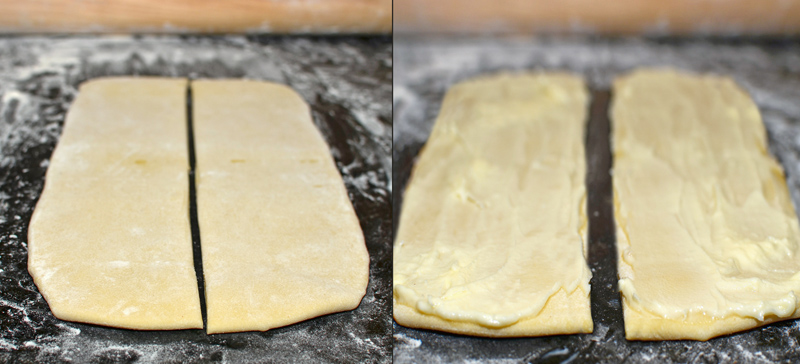
- Mix the butter and lamb fat in a bowl, and spread on the dough. Roll the first strip into a cylinder, then place it on the second strip and roll the whole into a thicker cylinder. Cover with plastic wrap, and refrigerate for at least 1 hour.
- Place the unwrapped cylinder of dough vertically on a floured surface. Using the palm of your hand, flatten the dough progressively to a 1/2″-thick, 7″-diameter disc. While doing this, sprinkle the top generously with flour, and flip the dough frequently — otherwise your dough will be stuck to the counter in a puddle of grease!

- Prick the flatbread with a fork to create a decorative pattern, then sprinkle the sesame seeds on top, and gently press with the palm of your hand to encrust the seeds in the dough.
- Transfer to a baking sheet lined with parchment paper, and bake in the oven for 25-30 minutes, until the top is golden brown. Transfer to a cooling rack, and reserve.
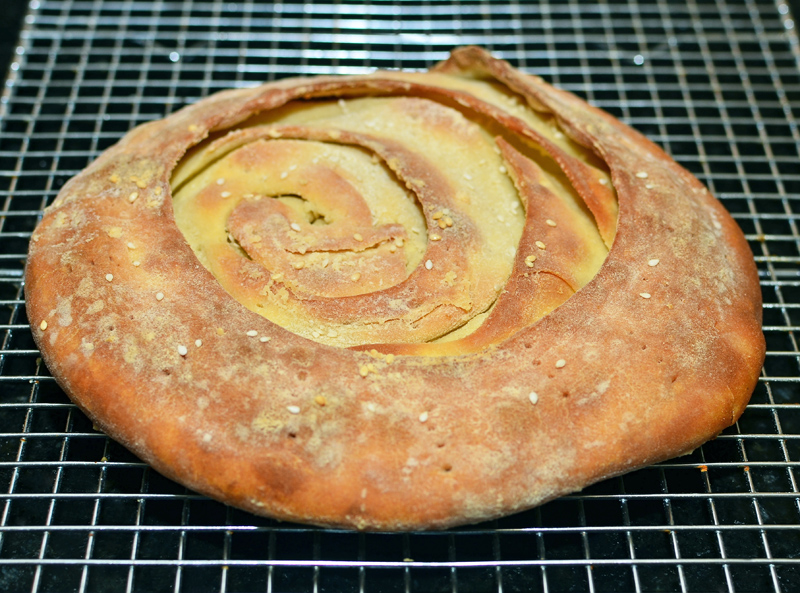
“Quick” qurut
Yields 4 qurut balls of about 1 oz each
18 oz plain whole milk yogurt
3/8 tsp (2.5 g) salt
- Pour the yogurt into a baking dish, and cook in a 300 F oven for 1 1/2 hours, without disturbing it.
- Pass the yogurt through a chinois, gently pressing with a spatula to extract more whey. Discard the liquid. Mix the solids with the salt, return to the baking dish, and cook for another 30 minutes.
- Remove the yogurt solids from the dish. If you’re a purist, divide the solids into 4 parts, and squeeze each one in your fist to make balls — this is the shape of the qurut sold in Central Asian markets. However, since we’re going to break down the balls to make the sauce in a minute, you can just reserve the solids in a container instead, without shaping them.
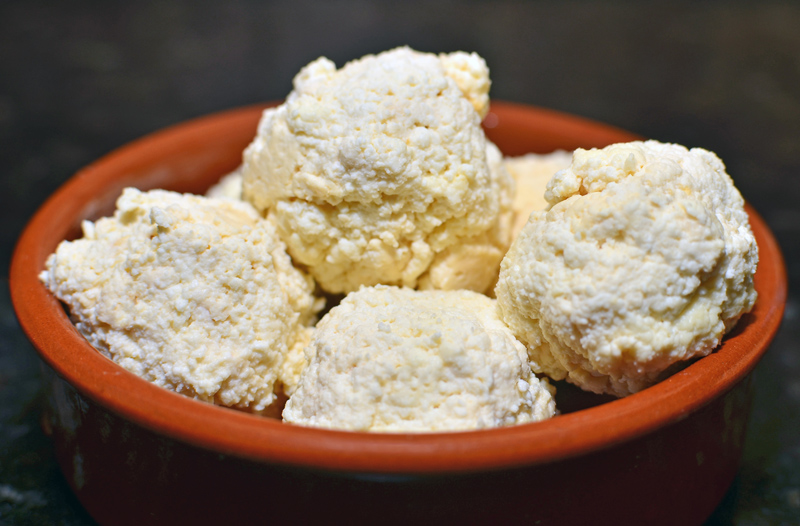
Roasted lamb shank
Yields 4 servings
1/2 tsp salt
1/4 tsp ground cumin
1/4 tsp ground coriander
1/8 tsp chili pepper
1 lamb shank (about 22 oz)
0.5 oz olive oil
16 oz tomatoes, quartered
- Mix the salt, cumin, coriander, and chili pepper in a container. Season the lamb shank with the spice mixture on all sides.
- In an oven-proof pan over high heat, sauté the meat in the oil until brown on all sides.
- Add the tomatoes, cover with a lid, and cook in a 300 F oven for 2 ½ hours.
- Remove the lid, and cook for another 30 minutes, flipping the shank halfway through. Take out of the oven, and let rest 10 minutes.
- Pick the meat from the bones, trying to keep it in large chunks. Remove the skin from the tomatoes. Transfer the cooking liquid to a plastic container. Reserve.

Qurutob
Yields 4 servings
7 oz onions, very finely sliced
1 oz olive oil
salt
“quick” qurut
roasted lamb shank (meat, tomatoes, and cooking liquid)
2 oz water
1/2 fatir
2 tsp parsley chiffonade
2 tsp basil chiffonade
- In a pan over medium heat, sauté the onions with the olive oil. Season with salt, and cook until golden brown, stirring regularly.
- Crumble the qurut balls into the pan, add the lamb cooking liquid and the water, then simmer for a couple minutes, stirring constantly. The amount of water you need to add may depend on the texture of your sauce. You want a sauce that’s pretty thick and lumpy, but still liquid.
- Tear the fatir into small pieces (1″ to 1.5″ squares), and toss into the pan.
- Transfer to a ceramic dish, and arrange the meat and tomatoes on top. If necessary, reheat in a 300 F oven for 5 minutes.
- Top with the parsley and basil. Serve the dish in the middle of the table and eat with your fingers.
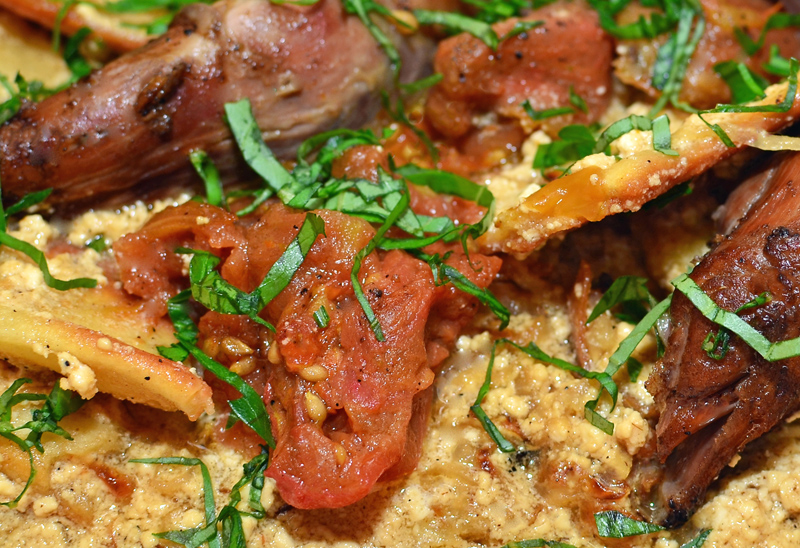

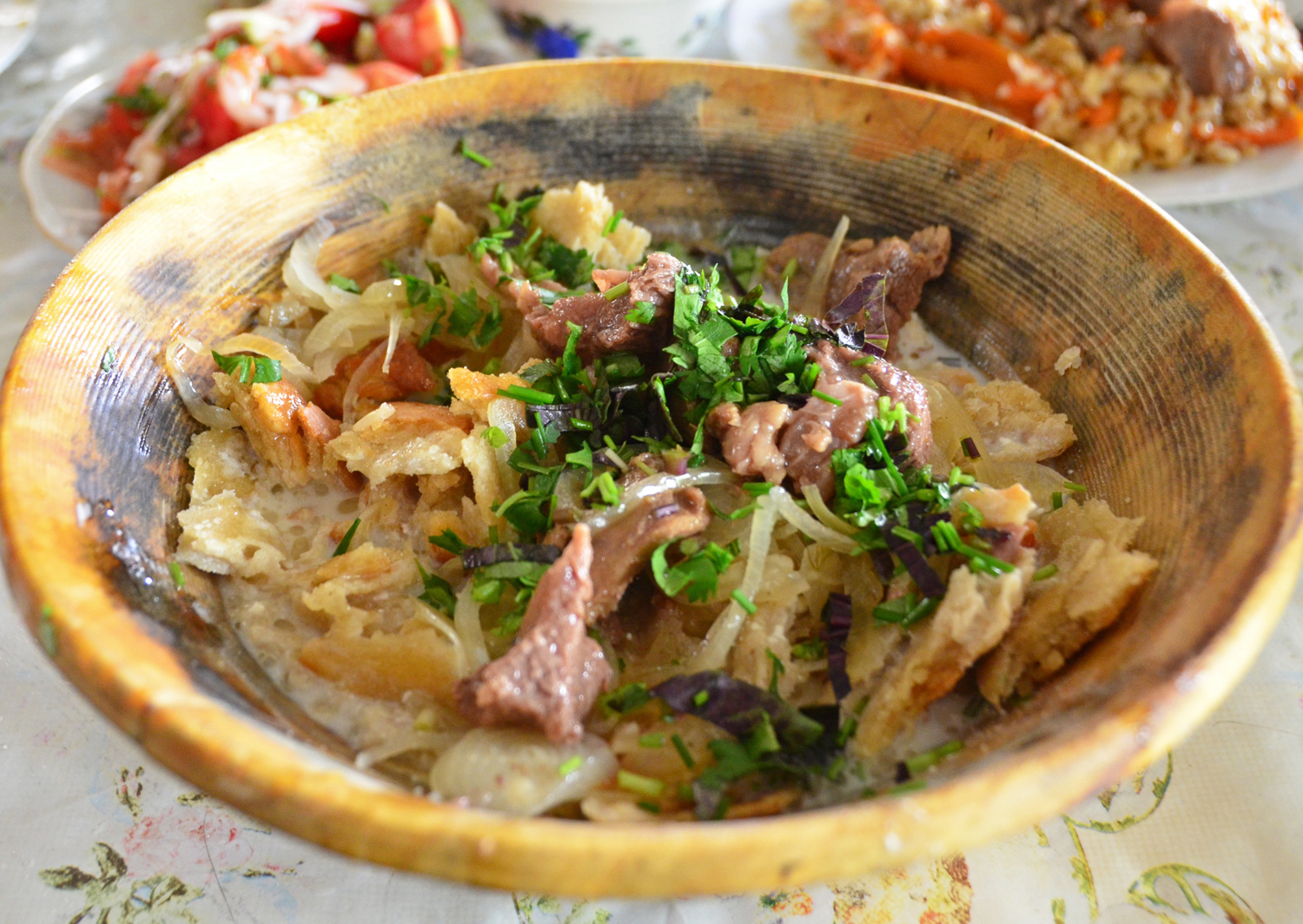
23 comments
Nice, Florian! What time is dinner? 🙂 Great post!!
Eileen
Yummy!!! Thanks for sharing!
Greetings from Stockholm, Sweden! 🙂
Gosh I’m most impressed you made the flatbread and the cheese balls from scratch to make this dish! It sounds very tasty.
Thanks, Maninas! Once you have a working recipe, they’re not that long to make. Try them!
This sounds great – what would you use for the vegetarian version? Just leave out the lamb? Or could you add chickpeas or lentils or something like that?
The vegetarian versions just leave out the lamb. Feel free to add more vegetables, I’ve seen pictures of qurutobs with carrots.
Impressive work!
Thanks! I’m using the Fatir for a school project on Tajikistan
This is not Qurutob! this is perverted type of Qurutob!!!! please don’t wrote such stupid recipe and call it as “Tajik Qurutob” – if you are really don’t know how it can be prepared… Hope you will think about it…
I tried this recipe because I was making a national dish from every country Marco Polo has visited (in my humble (nonhistorian) opinion) and I liked it. It’s very hard to come up with an original recipe if you’re not a native from any country, but while criticism is easy, improvement is harder. What do you think is the ultimate qurutob? Would you be so kind to give us “the” traditional recipe? I would be very grateful for that.
Hi Marco, I think the traditional recipe would skip the meat and use ready-made fatir and qurut (whether bought at the market or made at home ahead of time).
That’s OK, Tajik Guy, this is perverted type of blog…
Thank you Florian, for both the recipe and the reply on my comment, but I was actually asking Tajik Guy, since he sort of claims to be from Tajikistan.
Hi Florian, thanks for improvising the Tajik qurutob recipe by adding meat in it, which kind of reminds me of eating Turkish Iskendarkebap. As for your comment on the only two national dishes, plov and qurutob, is not a true and not fair to the Tajik people. There is mantu, khonuma, oshi tuppa (Tajik noodles with options of having it with soup like or with less water).. Could it be due to scarce Tajik kulinary literature, as you mentioned. As for Uzbeks and Tajiks, no matter how much these brothers would like to stand one from another, both have the same culture, traditions and food, with the exception of language.
Nowadays, people don’t have patience to make things from scratch. If any of you want a shortcut or simpler way:
1) just mix warm water with “chakka” (cheese left from yogurt when water removed) to make the mix like yogurt. Or you could use natural yogurt as well.
2) Mix in fatir (nowadays all is sold in the bazaar) or any round Tajik bread, or Indian nan or chapati.
3) chop and fry onions in butter slightly (adding tomatoes are optional) and pour on top of qurutob
4) add bunch of each chopped cilantro, green onions and any other greens you enjoy on top (parsley, basil, dill)and as much as you like.
5) And enjoy!
Thanks for your comment, Tajik Girl! When I said there were only two national dishes, I didn’t mean they were the only Tajik dishes — I agree with you there are many more. Plov and qurutob are just the ones that are the most often mentioned as the most “representative” of Takististan. Check out this list, for example.
As for adding meat to qurutob, this is something I actually saw in a Dushanbe restaurant!
Wonderful recipe. I would love to try it from your hands, maybe we could arrange it some day?
comanche_napstar@list.ru
Tajik boy my kid is making a school project about Tajikistan and I need an kids-friendly tajik food, any suggestion???
Hi everybody,
Last week I saw a cookbook/anthropological research about recipes from the Pamir Mountains (Afghanistan/Tajikistan): “With our own hands” by Frederik van Oudenhoven (October 2015).
Just to let you all know.
Thanks for sharing! I’m going to buy this book right now!
Just stumbled across your post while browsing for recipes from Tajikistan. I was looking because I’ve just bought this book – it just came out and might interest you too – https://www.amazon.co.uk/Samarkand-Recipes-stories-Central-Caucasus/dp/0857833278/ref=sr_1_1?s=books&ie=UTF8&qid=1468244037&sr=1-1&keywords=samarkand
I’ve already made a few things from it and they were delicious – afraid I can’t testify to their authenticity as I’ve never visited any of the Central Asian countries or the Caucasus, but it seems as though the food from this part of the world is getting a bit more attention!
Just discovered shankleesh at our local ethnic market and it is remarkably similar to the qurut I tasted from Kyrgystan with the only difference being the degree of dehydration. This shankleesh or ” Pickled Labneh ” as it is labeled is in jars covered with oil is from Lebanon. It is quite dry and crumbly without any oil penetration into the ball and would be an even quicker sub for the real deal. Have eaten Qurutob at Cafe Dushanbe in Sheepshead Bay, my only taste reference and loved it to the last drop. Glad my back was facing the door so they didn’t see me wiping the bowl with my finger…..
This dish is so good! I made it over the weekend exactly as called for except I used mutton instead of lamb (it’s what I had, and I find mutton more flavorful anyway). Just excellent. The combination of the spicy roast tomatoes and sour qurut was particularly tasty, I can see why this dish is so popular. I will definitely be making this again. I don’t have any more shanks but I suspect other cuts of mutton would work pretty well too.
For an easy way of making this dish, you can use plain Greek yogurt.